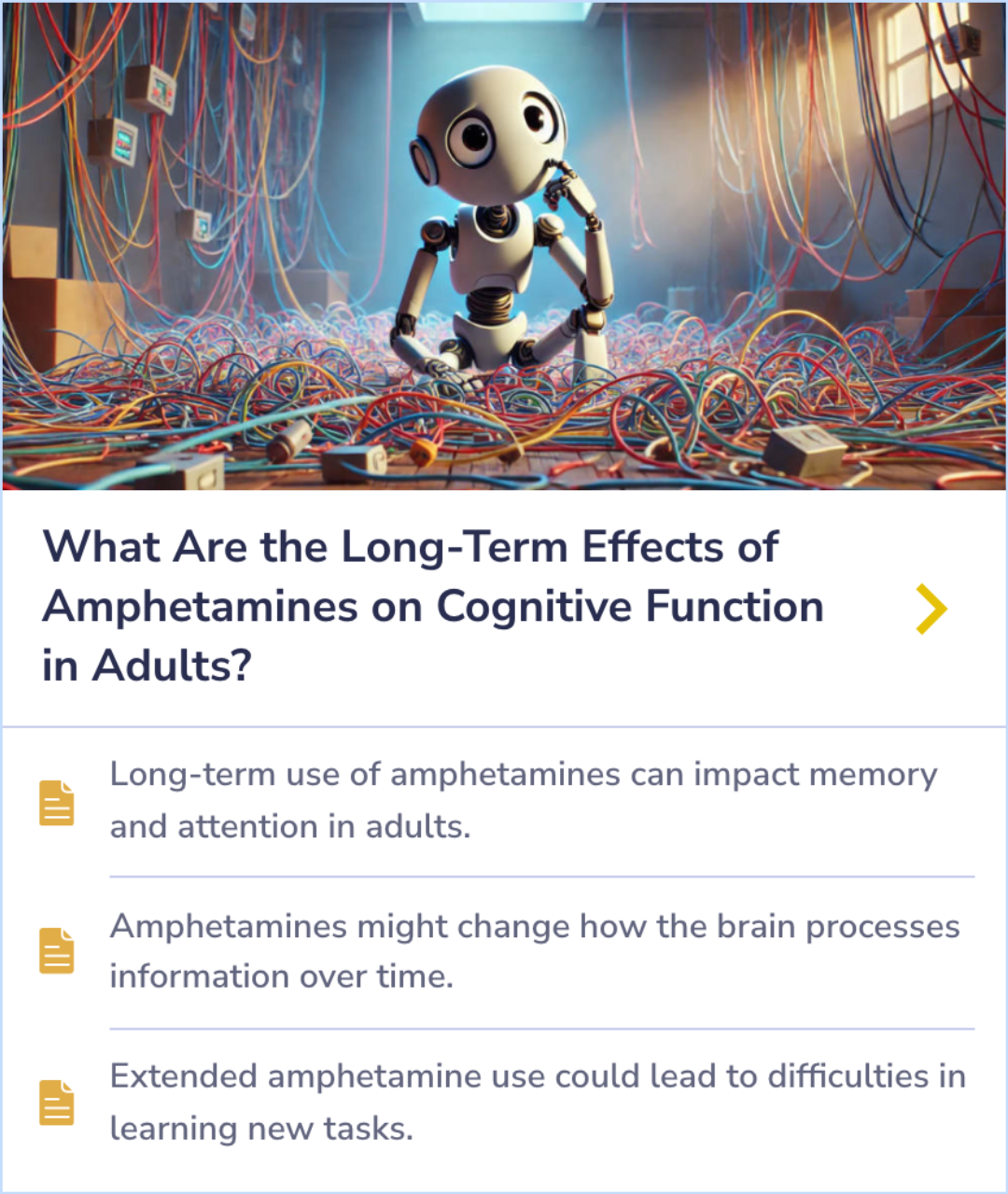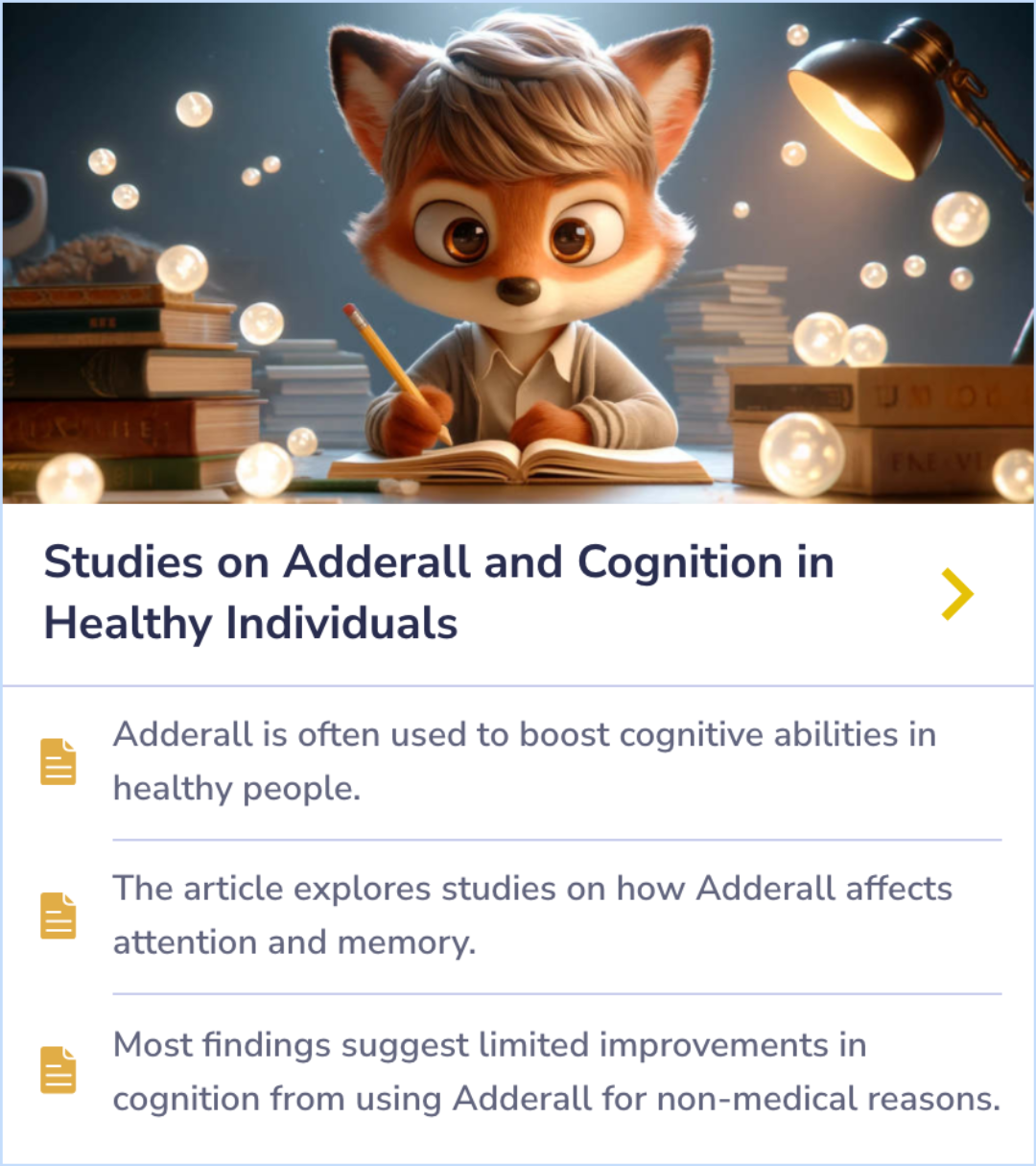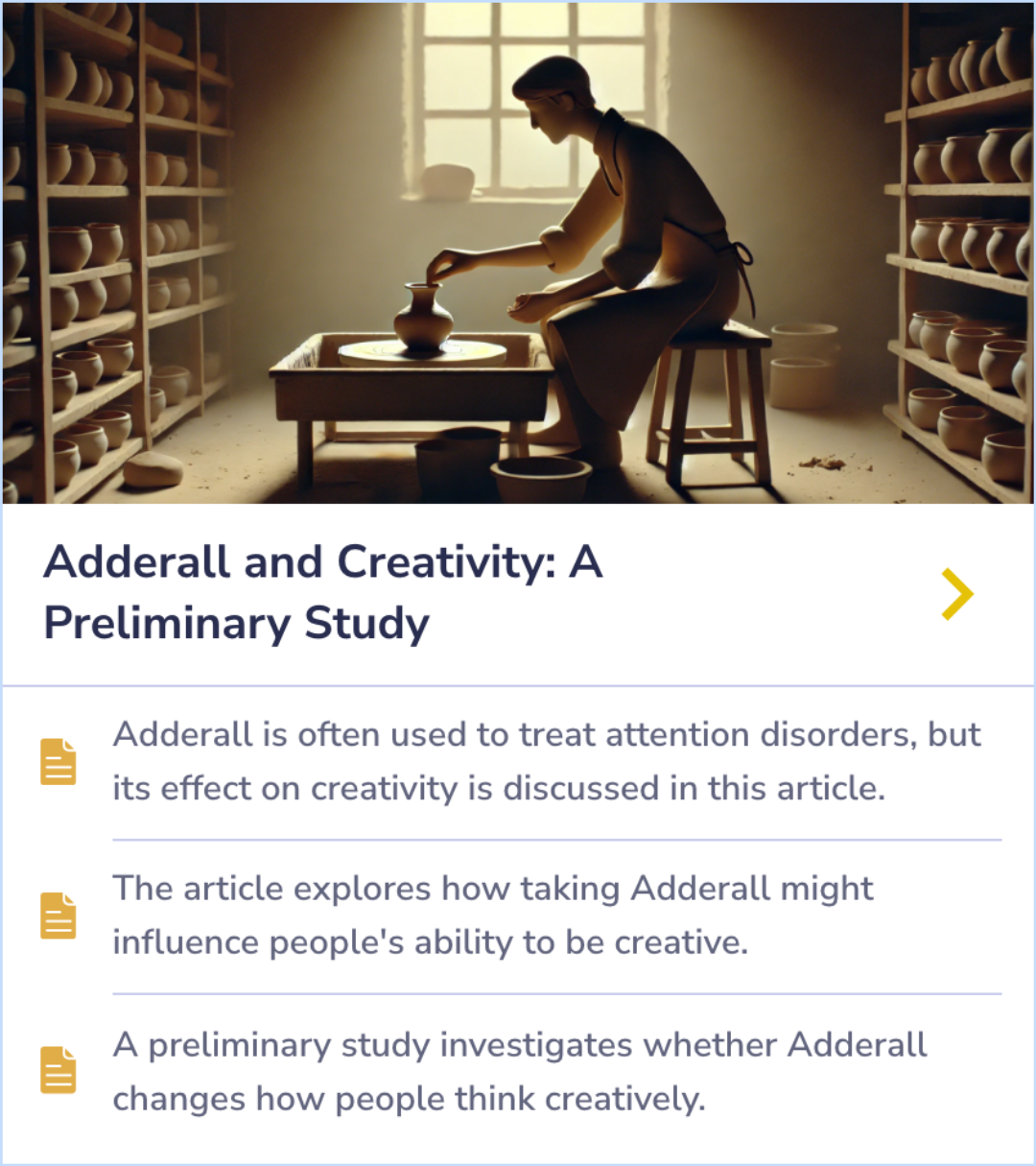Adderall
Evidence Based Answers
What Are the Mechanisms Behind Adderall (amphetamines) Ability to Enhance Cognitive Performance?
Adderall enhances cognition by keeping neurotransmitters active longer, boosting dopamine levels in the brain, and increasing catecholamines in the prefrontal cortex.
Published: October 24, 2024
Click to explore a section:
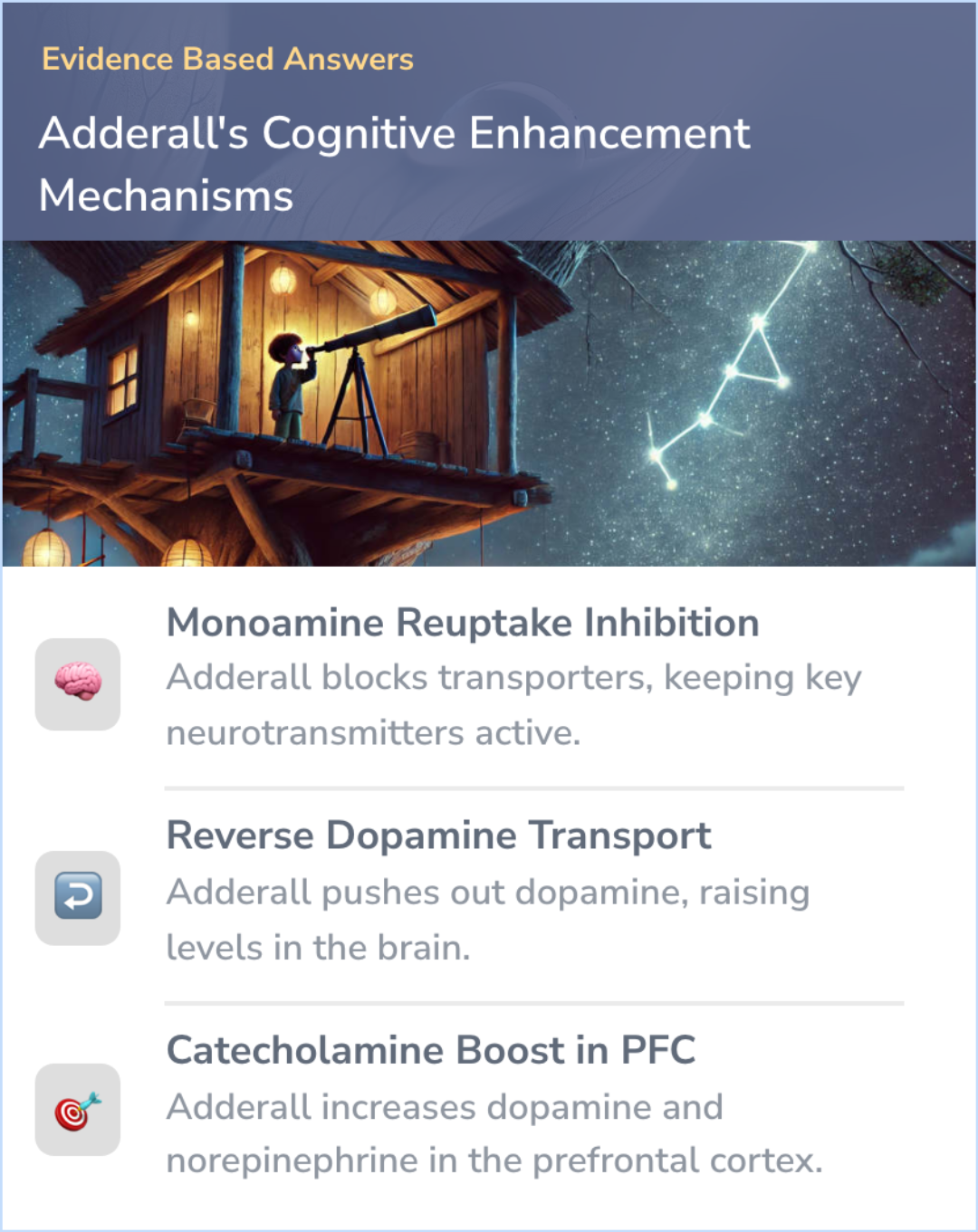
Adderall raises key brain chemicals, enhancing focus and cognitive abilities.
Monoamine Reuptake Inhibition: The Mechanism Behind Cognitive Enhancement
Adderall enhances cognitive performance by inhibiting the reuptake of key neurotransmitters like dopamine (DA) and norepinephrine (NE). This action increases their levels in the synaptic cleft, allowing these neurotransmitters to remain active longer, which is important for improved focus and cognitive function.
By blocking the transporters that usually clear these neurotransmitters, Adderall ensures a sustained release, contributing to its effectiveness in enhancing mental alertness and cognitive capacity.
By blocking the transporters that usually clear these neurotransmitters, Adderall ensures a sustained release, contributing to its effectiveness in enhancing mental alertness and cognitive capacity.
“
Source Quotes:
Amphetamine competes with the endogenous monoamines for transport into the nerve terminals via NET, DAT or SERT, the higher the concentration of amphetamine present in the synapse, the greater the number of amphetamine molecules transported relative to every molecule of monoamine.
The main mechanism of action of AMP is to increase synaptic extracellular DA and NE levels. This effect is mediated by inhibition of DA transporters (DAT) and NE transporters (NET), which reduces the reuptake of these molecules from the synapse.
Reverse Transport: Enhancing Dopamine Release
Adderall enhances cognitive performance by promoting the reverse transport of dopamine. Instead of dopamine being taken up from the synapse, it is pushed out of the neurons, increasing the levels of this neurotransmitter in the brain.
This reverse transport mechanism allows Adderall to release more dopamine into the synapse, which plays a key role in its stimulant and cognitive-enhancing effects.
This reverse transport mechanism allows Adderall to release more dopamine into the synapse, which plays a key role in its stimulant and cognitive-enhancing effects.
“
Source Quotes:
The outcome of these actions is that the direction of the reuptake transporter reverses, so that instead of pumping neurotransmitter from the synapse into the nerve terminal, it pumps neurotransmitter out of neurones into the synapse.
The net result of this activity is increased efflux of dopamine into the synaptic cleft and reuptake inhibition in the synaptic cleft through DAT internalization and direct competition.
Catecholamine Modulation in the Prefrontal Cortex
Adderall is particularly effective at enhancing cognitive function by increasing catecholamine levels—specifically dopamine and norepinephrine—in the prefrontal cortex (PFC). This brain region is important for attention, decision-making, and other executive functions.
The localized effect of Adderall in the PFC makes it especially effective at improving cognitive tasks that require focus and sustained attention.
The localized effect of Adderall in the PFC makes it especially effective at improving cognitive tasks that require focus and sustained attention.
“
Source Quotes:
Cognition-enhancing doses of psychostimulants produce relatively large increases in extracellular NE and DA in the PFC and modest alterations in spontaneous and evoked catecholamine neuronal discharge.
The ability of low-dose psychostimulants to improve PFC-dependent function is consistent with evidence indicating ADHD is associated with a dysregulation of fronto-striatal circuitry.
Inhibition of Monoamine Oxidase and its Impact on Cognitive Function
Adderall also inhibits monoamine oxidase (MAO), an enzyme that breaks down neurotransmitters like dopamine. By inhibiting MAO, Adderall prevents the degradation of dopamine and other neurotransmitters, further increasing their levels in the brain.
This inhibition supports the enhanced cognitive effects by ensuring that dopamine remains available to aid in processes like attention and focus.
This inhibition supports the enhanced cognitive effects by ensuring that dopamine remains available to aid in processes like attention and focus.
“
Source Quotes:
Although amphetamine is a relatively weak inhibitor of MAO, in the situation where amphetamine is concentrated in presynaptic nerve terminals, it is probable that some inhibition of this enzyme would occur.
Amphetamine also inhibits the metabolism of monoamine neurotransmitters by inhibiting monoamine oxidase (MAO).
Key Takeaways
Conclusions
Amphetamines enhance cognitive performance primarily by increasing levels of neurotransmitters, such as dopamine and norepinephrine, in the brain. This increase is achieved through mechanisms including the inhibition of reuptake, reverse transport, and monoamine oxidase inhibition, all of which allow these neurotransmitters to remain active and available for longer periods.
By focusing their effects in the prefrontal cortex, amphetamines improve cognitive tasks related to attention and decision-making, providing a notable boost to mental alertness and cognitive capacity.
By focusing their effects in the prefrontal cortex, amphetamines improve cognitive tasks related to attention and decision-making, providing a notable boost to mental alertness and cognitive capacity.
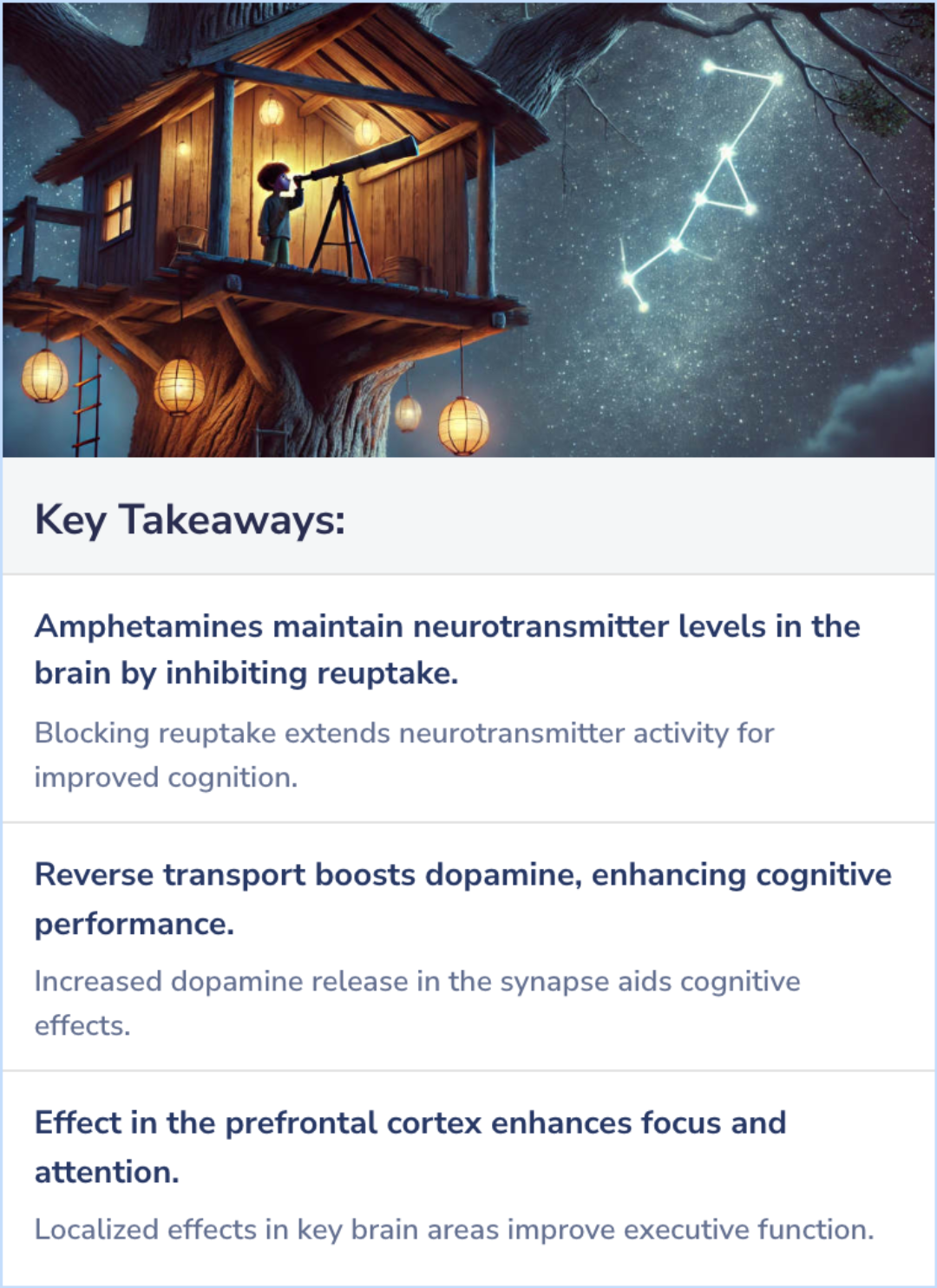
Evidence Summary
Long-term Amphetamine Use Alters Cognitive Functions
Prolonged amphetamine use in adults may change memory, attention, and how the brain processes information. These alterations can make learning new tasks harder and could affect everyday mental activities.
Over time, amphetamines might adjust how the brain processes information, potentially leading to challenges in acquiring new skills. Memory and attention seem particularly impacted by long-term use.
Over time, amphetamines might adjust how the brain processes information, potentially leading to challenges in acquiring new skills. Memory and attention seem particularly impacted by long-term use.
Evidence Summary
Evaluating Adderall's Cognitive Boost in Healthy Users
Examining Adderall's influence on healthy individuals, the focus is on its effects on attention and memory. While many turn to Adderall aiming to boost cognitive skills, studies mostly show minor enhancements for non-medical usage. The discussion highlights the debates about Adderall's true efficacy as a cognitive enhancer.
This ties into the broader topic of amphetamines and their ability to elevate cognitive functions through mechanisms impacting neurotransmitters.
This ties into the broader topic of amphetamines and their ability to elevate cognitive functions through mechanisms impacting neurotransmitters.
Evidence Summary
Exploring Adderall's Influence on Creativity
This piece examines how Adderall, often used to treat attention disorders, might influence creativity. The focus is on whether the drug impacts creative thinking, with a preliminary study exploring changes in innovation and thought processes. The discussion centers on the potential effect of Adderall on people's creative abilities.
The exploration raises questions about how the drug may alter the way creativity manifests, offering insight into its broader cognitive effects.
The exploration raises questions about how the drug may alter the way creativity manifests, offering insight into its broader cognitive effects.
